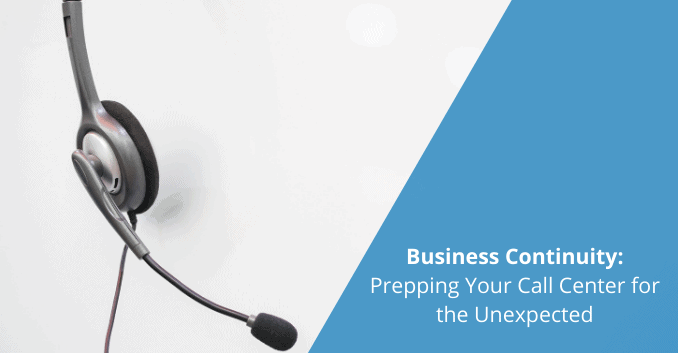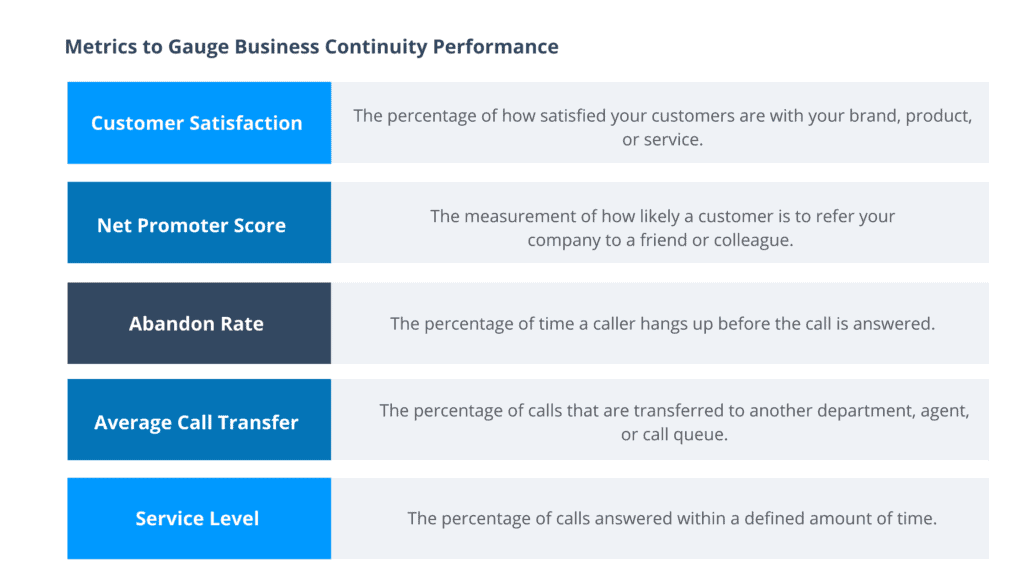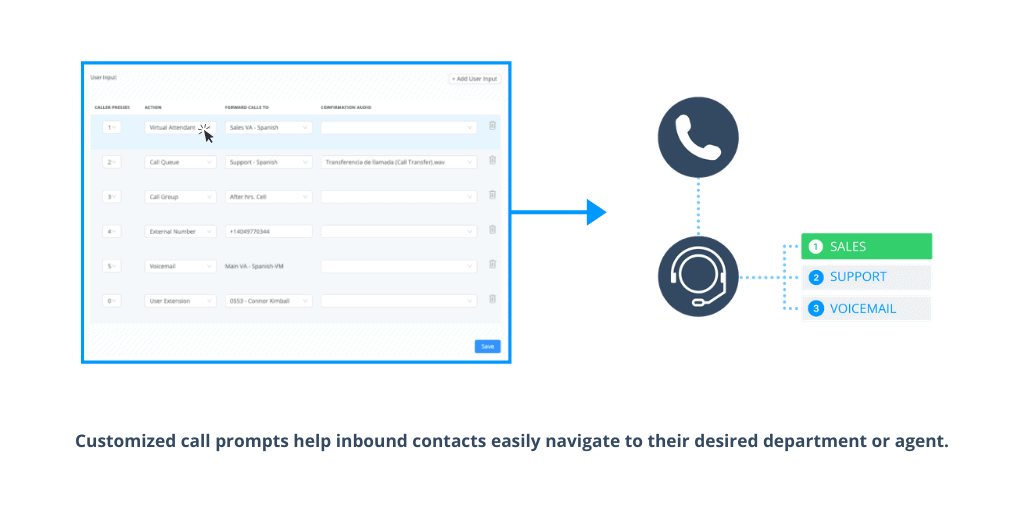BCP: Prepping Your Call Center for the Unexpected

What every business needs is a robust and detailed continuity plan to help with disaster recovery. Operational downtime - no matter how short - can add undue burden and appear suddenly at any time. Companies have experienced losses of $10,000 to $5,000,000 per hour as a result of inactivity. Imagine if you lost a full workday? That could significantly impact your bottom line.
Unexpected interruptions can hit your business hard, which is why you need a continuity plan in place and system capabilities that provide support to minimize downtime and keep your business running. Your customers are calling regardless, and without a plan to keep operations (and your communications) moving efficiently, you risk losing their confidence in your brand and sending them into the arms of another provider. And you definitely don’t want that.
The Significance of BCP in Your Call Center
Having a business continuity plan (BCP) for your call center serves one major purpose: to safeguard your business in the event of a major disruption and ensure you’re still able to facilitate your inbound and outbound call needs.
Call centers have a duty to their customers to keep communication channels open, even when operations go temporarily dark because of a situation outside their control. Several disruptions can impact your business - some notable examples include:
- Inclement weather (heavy snow, excessive heat, heavy rain, freeze, etc.)
- Power outages
- Fires
- Natural disasters (earthquakes, floods, blizzards, hurricanes, tornados, landslides, etc.)
- Epidemics & pandemics (hopefully never again!🤞)
- Civil disorders (protests, riots, strikes, etc.)
- IT system failure
- Public transportation failure
Recovery after an operation gap (even a small one) can be difficult to make up. Brands need to keep it business-as-usual for their contacts, and a fool-proof disaster recovery checklist can help your organization’s operation get moving again.
Businesses with the most successful continuity plans are the ones whose customers aren’t even aware that a disruption has occurred on the backend. Having a plan in place ensures your customers have a consistent and pleasant experience - no matter the hardship. If you can’t provide it, you run the risk of them phoning a competitor for assistance instead.
Keeping an eye on your service level metrics during a business disruption is equally important. If you have a strong plan set you’ll be in a good spot to maintain important KPIs like CSAT, NPS, Abandoned Call Rate, Average Call Transfer, and more.

COVID-19 is a highly relevant example of a disaster that took a major toll on numerous industries and companies around the world. It was the catalyst that put many BCPs to the test and wreaked havoc on those without. FEMA discovered that one in five companies are operating without a recovery plan to fall back on. Recuperating the losses from the pandemic will be difficult to bounce back from - could your business still continue to operate without one in place?
Building Out Your Call Center Contingency Plan
Building out your call center contingency plan takes time to implement and execute. Your business’s course of action should be documented and accessible to everyone in the organization, but that does not mean the plan is concrete for life. As your company evolves and customer challenges change over time, you’ll need to update your plan to keep it pacing with the trajectory of your organization.
While a contingency plan does add a level of acumen in the eyes of customers, agents benefit greatly from continuity too. A written and distributed plan, describing the steps every department and employee must take when disruption strikes an internal area, must be detailed and observed by everyone for it to work at full capacity.
If you have a plan in place…
Audit your current plan. Functioning during an outage and then resuming normal operations is critical for satisfied customers and the success of the business. Continual monitoring and reviewing the health of your business continuity plan and recovery processes can help stakeholders determine if changes need to be made for the plan to be more effective. Auditing processes differ from company to company, however, performance metrics assist C-suite in understanding what went right and wrong during operational downtime.
If you don’t...
Assemble a disaster recovery team. Having a designated group in charge of the development and implementation of your BCP and disaster recovery is important for the legitimacy and distribution of the plan to departmental teams. A disaster recovery team is held accountable for the creation of a sound and revenue-driving environment amid a disruption, as well as taking on the tasks of testing, reviewing, and updating the plan as needed.
Create call flows. Every meticulous continuity plan has a series of premeditated call flows that support its customers and agents in a time of crisis. Uninterrupted performance across all of your communication channels is essential for a great customer experience. Assessing each situation, and applying an intuitive call flow structure, helps calls get answered quickly. Identifying these call flow processes allows businesses to leverage Call Forwarding functionality, providing managers the ability to redirect calls so they never go unanswered again.
Start testing. After the plan is laid out, you should begin testing to confirm it works. Testing should be frequent enough to identify performance gaps within the strategy itself. If you just dive into the plan without making sure it’s sound for your business, you risk dissatisfying your customers and worse, losing revenue.
Distribute the plan. The disaster recovery team is also responsible for distributing the contingency plan after the green-light is given from internal stakeholders. It needs to be distributed through the channels (communication software, email, intranet, etc.) most trafficked by your employees before training can officially begin.
Begin continuity training ASAP. After your agents have had the opportunity to review the plan, you can begin the training on it. You’ll want to break them out into groups to go over the details of the call flow, inbound processes and workflows in place, as well as your expectations of them if the continuity and disaster recovery plan takes effect.
Cloud Communications Software to Fortify Your BCP Roadmap
Recognizing the challenges that are most likely to impact your call center operations and communications are all a part of the continuity planning process. Your BCP roadmap requires a solid strategy and sturdy cloud communication infrastructure to prepare for the unexpected. Having a trusted technology partner who can provide you with the essential cloud-based tools to support your strategy is key.
Whether it’s global voice or contact center solutions, cloud communications software can help your business fortify your BCP roadmap in a variety of ways.
Voice Solutions
Expansive and reliable voice coverage is a must for your business continuity. Global toll-free, non-geographic, and local carrier numbers help your operations re-route calls to numerous countries and cities across the globe with ease. Having a local presence is a beautiful thing, especially when your main revenue stream is disrupted. Retailers have turned to local virtual numbers to sustain revenue while their brick and mortar locations remain closed due to COVID-19. You can read more about this unique use-case and others, here.
Intelligent call routing systems help agents save time and never miss a call. A hosted IVR lets you create custom routing prompts, a sort of virtual directory where callers navigate to the department or agent that best fits their needs. IVRs not only ensure a dependable brand presence during a crisis but can also free up support agents from taking an overwhelming number of customer calls. For example, callers in a task-based navigation system, such as bill pay or ID verification, may never have to interact with an agent at all. Customers get quick resolutions to their problems, allowing agents to spend more quality time with others who need assistance.

Call distribution is a function of your ACD, which gives agents and management the ability to direct inbound calls automatically based on the rules assigned to it. Call Forwarding, as mentioned earlier, is a call management feature your team needs to forward calls to an external number, IVR system, mobile, or a specific user or team relative to the time of the call or agent-based skills.
As a supervisor, you have a lot on your plate when it comes to addressing every call that comes in. In crisis mode, the quality of phone calls may fall short. Call Recording provides you with a simple way to check in on the call quality of your team, helping to ensure that every interaction is on par with your company goals and customer service expectations.
Call Center Solutions
The right contact center software can help strengthen your business continuity strategy by streamlining communication and tracking team performance. Having access to a VoIP Softphone gives your team the ability to take calls wherever and whenever they need, as long as they have Internet access. It’s ideal for remote teams - there’s zero physical equipment and agents can handle the call queue with no disruptions.
Contact center software also gives businesses the ability to easily integrate other business tools so that essential data is syncing properly as your team works remotely. Combining Integrations like CRM, Helpdesk, and Chat with AVOXI’s contact center platform gives agents the flexibility to work out of just one platform instead of toggling between two. Automatic call activity logging is a big advantage for inbound and outbound agents. Rather than record the call manually each time, our system does this for you and syncs the recording into the system automatically. When the caller calls back - or the agent follows up - the known caller details from the CRM are populated into the softphone for easy and contextual details. Automated workflows can help teams tremendously when dealing with call volume surges following a business disruption.
Even if remote working is a temporary solution, AVOXI’s Bring Your Own Carrier allows on-premise call centers to maintain their existing infrastructure while enjoying the services and features of our contact center platform. SIP-trunking helps bring legacy infrastructure to the cloud, so agents can continue to support their customers every day from anywhere.
Managers of remote teams rely on our Advanced Analytics to monitor agent activity and determine when additional resources may be required. It helps managers keep an eye on their business’s performance where it matters most through conversation monitoring and KPI tracking in real-time and historical reports. With growing inbound call volume, maintaining quality and consistency standards can be tough. Live Call Coaching gives managers the ability to continue actively training their remote teams with call quality features that ultimately, improve the customer conversation.
Safeguarding Your Business with Cloud Technology
Business continuity plans are always evolving and need software support to streamline communication channels effectively. Without one in place, the repercussions can be severe...costing companies thousands to millions of dollars in expenses and lost revenue.
Your customers need resolutions to their problems quickly, and you don’t want to let them down because of system failure. AVOXI’s cloud communication solutions can ensure your contact center never goes down and provide critical support to your BCP. Our business continuity technology helps safeguard your business through call redirection and navigation when something unexpected happens - at home or in the office.
